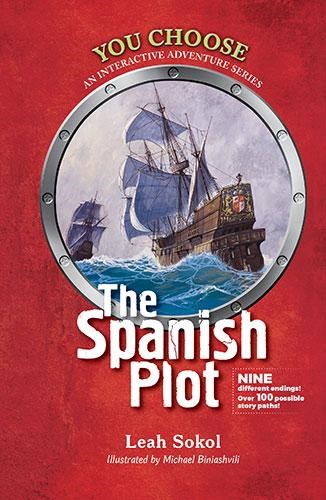Leah Sokol, Michael Biniashvili, illustrator
The Spanish Plot
Judaica Press, 2019, ISBN: 978-1607632931
Reviewed by Rochelle Strauss*
The Spanish Plot is an historical novel for young people (and those young at heart) by Leah Sokol. Set in 1492 in Toledo, in the kingdom of Castile, the title refers to a scheme hatched in the Spanish Court to kidnap the grandson of one of the most influential Jews at the time, Don Isaac Abarbanel. The Spanish monarchs, Queen Isabella and King Ferdinand, had hoped that if they kidnapped and converted the child to Christianity, then Don Abarbanel would agree to convert also and remain in Spain after the Edict of Expulsion. As mentioned in the novel, the renowned Rabbi Avraham Seneor, another important Jew at the Court, had agreed to convert, as had his sons and son-in-law.
The text is written in the interactive narrative form popularized by the “Choose Your Own Adventure” series, based on a concept created by Edward Packard in “Sugarcane Island” in 1976. Sokol describes “You,” with whom the reader identifies, as the Jewish child of the nurse to Don Abarbanel’s grandson. The story begins with “You” walking down the street with Yitzchak, the grandson of Don Abarbanel. You/reader notice a strange man staring at Yitzchak. By the end of the short first chapter, the man’s behavior frightens “You,” so You/reader are left with three choices before turning the page to continue. You/reader are told: “To wait and hear him out, turn to page 8; To grab Yitzchak and run, turn to page 11; To call for help, turn to page 13.” Similar options are repeated at the end of each subsequent chapter.
This narrative format in second person singular makes the reader feel as if s/he is the central character in the story. “You” read a number of action options and depending on the choice “You” make, “You” are directed to go to that chapter which continues the story line chosen. The idea of the reader deciding which action to take may also remind Hispanists of the revolutionary Rayuela (Hopscotch), by the Argentine Julio Cortázar published in 1963, in which the reader is also invited to become involved in the story; it was a groundbreaking narrative invention when in “Book II” Cortázar gave readers the option to follow the usual format or use his map to proceed reading the last ninety-nine chapters in a specific order that jumps (hence, “hopscotch”) around the chapters in a non-linear manner. LikeHopscotch and the “Choose Your Own Adventure” series, The Spanish Plot readers are given an opportunity to choose whichever ending suits their preference. More importantly, since The Spanish Plot deals with a specific historical event that is part of Jewish history, Sokol also echoes an important aspect of Jewish tradition. Jews are advised to believe that we were all part of the experience of key events such as the giving of the Torah at Mt. Sinai. We are also signaled in the Haggadah to act as if we were literally slaves in Mitzraim and were saved by Hashem. Many Sephardic Jews have the custom at the Seder to circle the table with a pack on their shoulder, recreating the pilgrimage out of Egypt. It is very appropriate, therefore, that this narrative format gives readers the opportunity to imagine they were in Spain at the time of the Expulsion, and at the same time as the first voyage of Columbus in 1492. Sokol’s “You” must decide among nine different endings with multiple possible story paths.
It is evident that Sokol has done careful research into the period and used reliable sources for information, such as Benzion Netanyahu’s Don Isaac Abravanel. Statesman and Philosopher (1953). She also presents a helpful epilogue in which she presents further historical context of the book’s story. The narrative format in which the reader chooses the next chapter keeps the story lively and engaging, even with the inclusion of many historical facts which gives readers much useful information. The choices are many since we recall that at that period Spanish history when the Jews were to be expelled, Columbus was also about to set forth on his sea journey. Sokol’s narrative incorporates the many decisions Jews of that time faced. She shows that some Jews opted to remain in Spain, while many fled to Naples and other more welcoming cities in order to evade conversion, as did Don Abarbanel. Some are said to have sailed with Columbus . One story path that is offered is part of the current trend to consider “alternative history,” which readers will find especially beguiling.
In addition to focusing on a crucial, climactic period in Spanish and Jewish history, Sokol offers a personal portrait of Don Abarbanel, who is considered to be one of the greatest Jewish statesmen as well as a figure of great importance in European history. He is described in the book not only as coming from a family of wealthy businessmen and an advisor to Queen Isabella, but also as a great scholar and devout Jew. “You” as reader meet him since “You” live in his home, and “You” get to interact with him as you both worry about the impending expulsion, the dangers to the life of his grandson Yitzchak, and the unknown future that lay ahead. Acknowledged historically as the last of the long line of great Jewish leaders and heroes of the Golden Age of Spain, for Sokol’s readers he becomes also a very “kind man” and a loving grandfather, a true role model for contemporary readers.
* Rochelle Strauss is a retired librarian, Brooklyn Public Library (NY).

